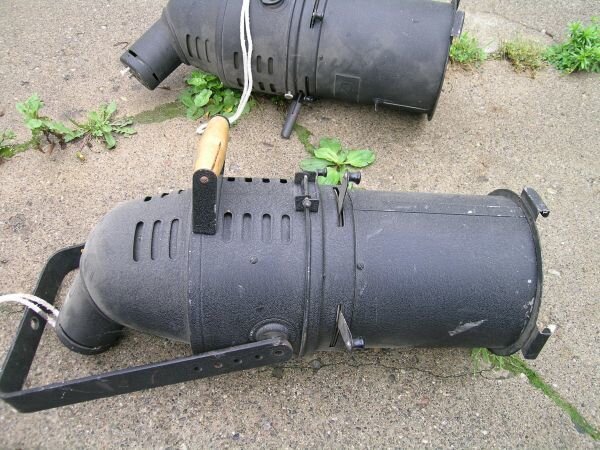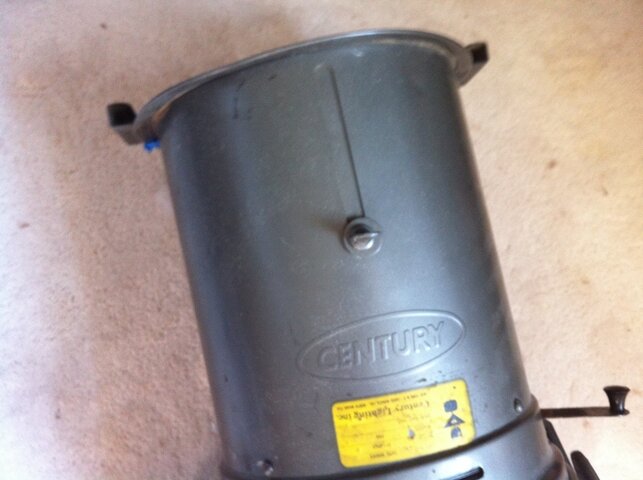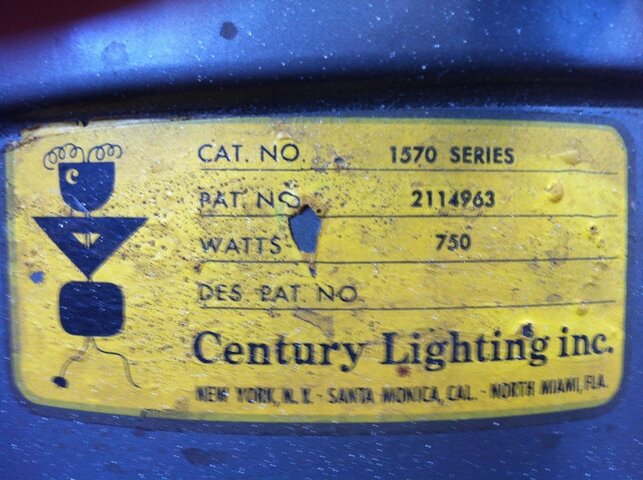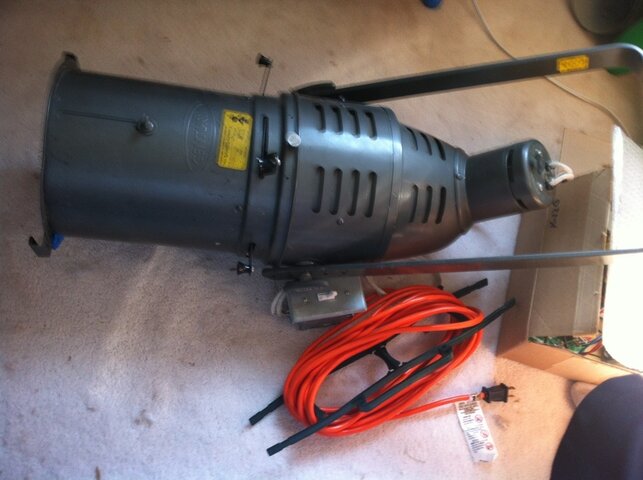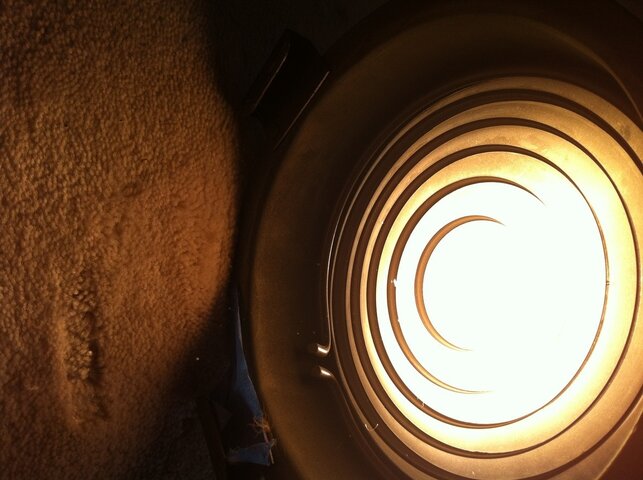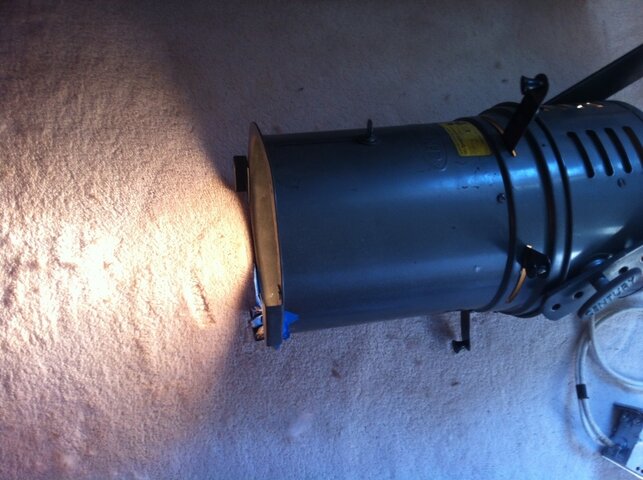You are using an out of date browser. It may not display this or other websites correctly.
You should upgrade or use an alternative browser.
You should upgrade or use an alternative browser.
Vintage Lighting Fixture
- Thread starterchris325
- Start date
They look like radial Altman 360's from the 60's or 70's to me.
Check out this thread.
It was the king of the ellipsoidal fixtures before the Source 4 was invented and there are still a lot of them out there.
Check out this thread.
It was the king of the ellipsoidal fixtures before the Source 4 was invented and there are still a lot of them out there.
Last edited:
Most definitely not. I'd bet those were manufactured between 1955 and 1965....according to the seller they were used in the Fisher Theatre in Detroit in the '30's.
jstandfast
Active Member
Handle on the 8" was added - note the color - doesn't hurt the value, just helps the history that comes with it if you can figure out who in the 60's added such a handle perhaps off another fixture so as to help it focus. The 8" is a Century #1560 in having one verified in part number for the 8" version at least in collection. Don't have the 6" version but my assumption is that it was invented in 1948 for their age. 1948 thru the later 50's for age for date. Possibly early 60's in date but don't think so in this case.
Similar to one by Hub I also own, but different in hole patterns and other details such as that flange about the lamp cap.
Similar to one by Hub I also own, but different in hole patterns and other details such as that flange about the lamp cap.
Last edited:
MPowers
Well-Known Member
To Complete the circle, these look like Capitols to me but YMMV. The are definitely NOT Altmans, and they are definitely NOT 1930's vintage. Late 50's earliest, probably mid 60's. One reason they could not be Altman's from the 30's is that Altman was founded in 1953.
I will take friendly exception the the earlier statement that the Altman 360Q was "....the king of the ellipsoidal fixtures before the Source 4 was invented...." The Ellipsoidal spotlight was introduced in 1933, by Century with the LeKo Light and Kliegl with the Klieg Light which, depending on where in the country you were, dominated the field. By the 60's, Altman became a major force but stayed (IMHO) #3 in the pecking order. One of Altman's first and most notable inventions was the PAR 64 which they introduced in 1966 for a Rolling Stones concert tour. In 1973, with the introduction of the 360Q Axial, Altman slowly over took Kliegl. By 1980, Altman was one of the major players, the exact market share and rank open to much debate. Especially in the heartland, there were a number of minor players, among them, Major, Hub, Lee, Electro Controls, L&E, Colortran(mostly west coast) , et. al. As century morf-ed into the present Strand, Davis to Electro Controls to a Strand subsidiary, the mid-west companies to oblivion, Kliegl faded to black and the new kid-on-the-block ETC emerged.
I will take friendly exception the the earlier statement that the Altman 360Q was "....the king of the ellipsoidal fixtures before the Source 4 was invented...." The Ellipsoidal spotlight was introduced in 1933, by Century with the LeKo Light and Kliegl with the Klieg Light which, depending on where in the country you were, dominated the field. By the 60's, Altman became a major force but stayed (IMHO) #3 in the pecking order. One of Altman's first and most notable inventions was the PAR 64 which they introduced in 1966 for a Rolling Stones concert tour. In 1973, with the introduction of the 360Q Axial, Altman slowly over took Kliegl. By 1980, Altman was one of the major players, the exact market share and rank open to much debate. Especially in the heartland, there were a number of minor players, among them, Major, Hub, Lee, Electro Controls, L&E, Colortran(mostly west coast) , et. al. As century morf-ed into the present Strand, Davis to Electro Controls to a Strand subsidiary, the mid-west companies to oblivion, Kliegl faded to black and the new kid-on-the-block ETC emerged.
Last edited:
techieman33
Well-Known Member
When I said "King of the ellipsoidals" I was meaning for that time period of the 70's and 80's before the S4 took over. Which you seem to at least partially agree with me on. There are still a ton of "vintage" 360q's in use out there in churches, schools, and community theaters.
There are still a ton of "vintage" strand/century units in use too.
Never heard that particular "myth" before. The most persistent fable is that Bill McManus convinced Charlie Altman to build the fixture for the 1964 New York World's Fair. [See post#16 below for validity.] In any case, Ariel Davis was several years ahead of them. More at PAR can.... One of Altman's first and most notable inventions was the PAR 64 which they introduced in 1966 for a Rolling Stones concert tour. ...
We've discussed elsewhere that, although there were better fixtures (at higher cost) available, the NYC rental shops Four Star, BASH, Vanco, and Production Arts made the 360Q the de facto standard ERS from the mid-1970s until 1992. Altman was always at a disadvantage to Century and Kliegl Bros. because they never developed control/dimming of their own.
Last edited:
Total noob shot in the dark here, but it looks almost exactly like some century (not century-strand) lights that we have in storage. They came out of one of the elementary schools, which had a century board. Ive borrowed them a few times for projects, there not all that bad of a fixture. Then again, Ive never really worked with modern conventionals like the source 4 family.
Last edited:
MPowers
Well-Known Member
...... it looks almost exactly like some century (not century-strand) lights that we have in storage.................
Post some pics so we can compare. Try to show any identification marks, labels or stampings.
MPowers
Well-Known Member
Never heard that particular "myth" before.
AFAIK, the Altman/Stones Tour "myth" is the Altman Family version. Personally I suspect All the myths have a shread of truth. Part of who's truth to believe is deciding which incarnation is the real first par can as we know it. Is the first real version simply when someone used 24v ACL in a shop built frame or the 120v Silver tube that we all know now, or somewhere in the middle. As mentioned, Ariel Davis tried to cut fixture costs drasticly by using reflector lamps in fixtures that we would genericly call (back then) a Davis LeKo. The terms Kliegl LeKo or Davis LeKo were common in the 60's, expecially in the southwest where the term LeKo was used for all framing shutter units. The Ariel Davis units were unfortunately cheap in every aspect of their being. A pain to focus, almost impossible to get a really sharp beam and the shutter pressure plate was inadequate and the shutters did not stay in place, the bottom shutter was often missing or you found it on the catwalk below the unit.
Last edited by a moderator:
Post some pics so we can compare. Try to show any identification marks, labels or stampings.
Here is the light, apologies for the the messy floor and the wavy images.
That wiring is not asbestos, its just cloth; our district had a specialist check over the entire inventory for asbestos a few years back.
IMO it most closely mirrors the closer one shown in the original picture, the far one looks shorter and fatter to me. This light does not have the wooden handle thing on the bottom though.





Attachments
Last edited:
PAR Can History???, Nook the LD did an article a year or two back on it and thought it was established history. I would recommend a link to this article as it is properly researched and should solve start/who did what type stuff for dating etc.
On the 6" Leko, find I do have optins on what it could be from photo, Century #1480 (or later Century/Strand #2211 or 2321.) I have the G-9.5 version which is probably while younger, more rare, Also a Century #1530 that could also be the case. The 6" Version has lots of similar hole patterns that could be any number of fixture.
On the 6" Leko, find I do have optins on what it could be from photo, Century #1480 (or later Century/Strand #2211 or 2321.) I have the G-9.5 version which is probably while younger, more rare, Also a Century #1530 that could also be the case. The 6" Version has lots of similar hole patterns that could be any number of fixture.
Last edited:
Mr. Schoenfeld's article was on the ACL, not the PAR can (unless you're referring to another?): PLSN | A Brief History of ACLs . See also http://www.controlbooth.com/forums/lighting-electrics/18874-par-acl-par-can-invention.html , specifically posts #4 and #21.PAR Can History???, Nook the LD did an article a year or two back on it and thought it was established history. ...
I think the dates are slightly askew in the Bill McManus obituary (along with the fact that the "Cine-PAR, originally built by Kliegel [sic] Brothers for the newsreel industry" was actually the Cine Queen, by ColorTran). It has McManus approaching Ronny Altman about 1975, which seems much too late.
In any case, I've found no substantiation for "McManus had Altman build the PAR can for the 1964 New York World's Fair." Mea culpa. Change MPowers' "Rolling Stones" to "Jethro Tull" tour and his version works.
-----
Aman121, your fixture is much newer than the ones in post#1. The "Century Man" logo was only used for a very brief time, I think between 1963 and 1969, maybe less, per the timeline at http://www.controlbooth.com/wiki/Collaborative+Articles:Memory+Lighting+Control+Systems+History. Perhaps kcraigie of Vincent Lighting Systems knows for sure.
Interesting that your abatement specialist did not identify the wiring insulation as asbestos containing. I'm skeptical.
Last edited:
Aman121, your fixture is much newer than the ones in post#1. The "Century Man" logo was only used for a very brief time, I think between 1963 and 1969, maybe less, per the timeline at Memory Lighting Control Systems, History - ControlBooth. Perhaps kcraigie of Vincent Lighting Systems knows for sure.
That "Century Man" logo has me stumped. I've combed through data sheets and a few brochures from the 50s and 60s, and found no use of that particular logo on either type of marketing materials. However, Aman121, if you'd like to see a data sheet on the 1570 series from either 1959 or 1966, I can scan those for you.
I DID find the logo on a Preliminary drawing. Although the drawing was dated 1958, I suspect that the logo may have been placed there with the copyright of 1962. So, Derek, your date estimates appear to be pretty spot on. I'm pretty sure when Rank bought Century Lighting in 1969, they started using the Gong Man logo.
Not to be left speculating, though, I put in an email to my contact at Strand Lighting, who is currently out of town. If I find out anything else, I'll share. Now to return you to your regularly scheduled thread ...
Last edited by a moderator:
Thanks for your efforts, Kim. Here's another label,

this time, courtesy of eBay, from a 6" Fresnel, (starting bid $44.99, Buy It Now $125, "COMES WITH HARD TO FIND CLAMP").
Interesting that this label only lists the NYC and CA locations. One might surmise it was before the expansion into FL. In case anyone wants to retroactively send a letter to Century Lighting in the 1960s, here are the complete addresses from a Sales Brochure:
521 West 43rd Street, New York 36, N. Y.
1820 Berkeley Street, Santa Monica, Calif.
1477 N. E. 129th Street, North Miami, Fla.
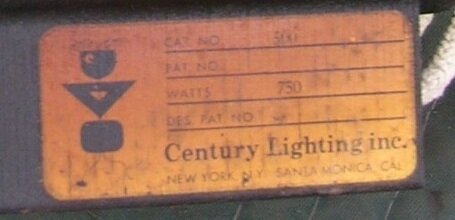
this time, courtesy of eBay, from a 6" Fresnel, (starting bid $44.99, Buy It Now $125, "COMES WITH HARD TO FIND CLAMP").
Interesting that this label only lists the NYC and CA locations. One might surmise it was before the expansion into FL. In case anyone wants to retroactively send a letter to Century Lighting in the 1960s, here are the complete addresses from a Sales Brochure:
521 West 43rd Street, New York 36, N. Y.
1820 Berkeley Street, Santa Monica, Calif.
1477 N. E. 129th Street, North Miami, Fla.
That's interesting about the logo, because according to the design documents those lights were installed with the rest of the system in 1961 when the school was built. I also was wrong about the century board, it was actually designed with an Ariel Davis diming system, hub strip lights and outlets, and century instruments. It was actually my first lighting system, but it was torn out the year after I moved on to jr. high school when they remodeled. I only got to use it for shows 3 or 4 times but I messed around with it a good bit. Taught me allot about electricity....
Here is the light, apologies for the the messy floor and the wavy images.
That wiring is not asbestos, its just cloth; our district had a specialist check over the entire inventory for asbestos a few years back.
IMO it most closely mirrors the closer one shown in the original picture, the far one looks shorter and fatter to me. This light does not have the wooden handle thing on the bottom though.
Not meaning to be picky, but is this setup even grounded? Between the kludged inline outlet box switch (dimmer?) and the wires that really really look like asbestos, you shouldn't be using this. It might also be a good idea not to test this on the carpet!
Last edited:
Similar threads
- Replies
- 20
- Views
- 1K
- Replies
- 9
- Views
- 572
- Replies
- 16
- Views
- 2K
Users who are viewing this thread
Total: 1 (members: 0, guests: 1)



